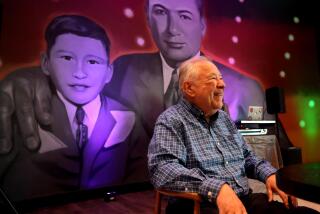Movie on Life of a Legend : Neighborhood Becomes Film Set
- Share via
Most Golden Hill residents at 28th and B streets were excited when a 50-person film crew rolled into their neighborhood Wednesday morning, on location for a feature film slated for a summer release.
Terence Frye, 12, was not among them.
On most days Frye and his friends ride their bikes to Wicks store, on the corner where filming was taking place, to buy candy. But Wednesday the candy outlet had been transformed into a 1930s grocery store for the filming of “Break of Dawn.”
Frye and other curious onlookers thought they had been invaded by Hollywood movie makers. In fact, the movie is a local production made by a San Diego company shooting its first feature film on a budget small enough to make Sylvester Stallone laugh.
“We’re making the film for less than $2 million, which is a very small budget,” said producer Jude Eberhard, who with screenwriter-director Isaac Artenstein has run Cinewest Productions in San Diego for 10 years. They are shooting “Break of Dawn” at more than 50 locations around the city.
The film is about Pedro J. Gonzalez, a legendary figure in Mexican-American history. Gonzales was Pancho Villa’s telegraph officer during the Mexican Revolution.
By the 1930s, Gonzales had become one of the most popular singers and best-known personalities on Spanish-language broadcasting in Los Angeles.
In 1934, he was accused of rape and sentenced to prison. The supposed victim later retracted her accusation but the judge who had sentenced Gonzales refused to free him.
There was a widespread belief that the charges against Gonzales had been trumped up as the result of his outspoken criticism of the deportation of Mexican immigrants and police brutality in the Mexican community of Los Angeles.
Gonzales spent six years in San Quentin prison. He was released in 1940 and deported.
He was allowed to return to the United States in 1971 to be near his seven children, who are all American citizens. Now 91, he lives in San Ysidro.
“His struggle is representative of the Mexican-American experience,” said Artenstein. “He was a man who stands for what he believes in.”
A 1983 documentary about Gonzalez, also made by Cinewest, won an Emmy Award and was shown at film festivals in Europe, Latin America and Asia.
“We wanted to make a film which shows more than just the stereotypes of Mexicans,” Eberhard said.
Eberhard said that, despite the prestige Cinewest garnered from the Gonzalez documentary, getting the money to make “Break of Dawn” was so hard that he had to resort to a little “begging.”
“I had to ask just everybody I knew to give some money,” Eberhard said, adding that “as independent film makers we don’t have the luxury of going over budget.”
Wednesday was the 29th of 34 hectic days of filming in the movie starring Pepe Serna and Socorro Valdez.
“We couldn’t have made this film without the support of the community,” Eberhard said. “We’ve used about 100 local people as extras and we’ve gotten incredible locations (in Barrio Logan, Golden Hill and near downtown) for free.”
The crowds of residents that gathered at 28th and B Wednesday curiously watched actors in a scene dealing with the arrests of Mexican-Americans by Los Angeles police in the 1930s.
The crowd hushed as action was called by Artenstein and laughed as mock struggles took place during a violent arrest scene.
Actors wore period clothing and old-fashioned police paddy wagons were used.
“I think it’s kind of neat,” said Millie Pedrin, who lives a block from the scene and watched the filming with her children. “It’s great the way they have changed everything.”
Terence Frye disagreed.
“I don’t like it because I like to go in there and buy candy,” he said.
“Sometimes we get candy for free after school,” he said, adding that he and his friends would be glad when the film crew left so they could buy candy again.
More to Read
Only good movies
Get the Indie Focus newsletter, Mark Olsen's weekly guide to the world of cinema.
You may occasionally receive promotional content from the Los Angeles Times.










